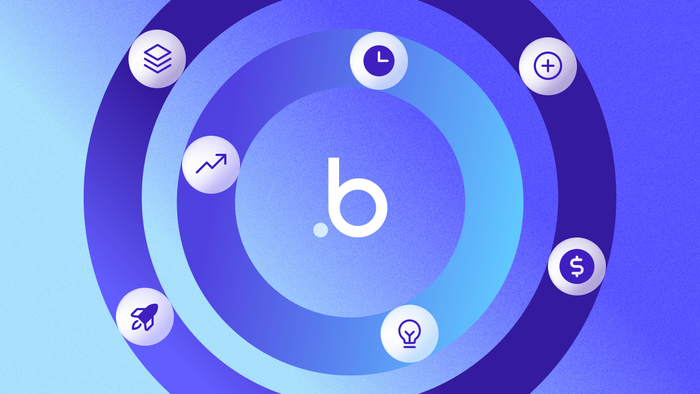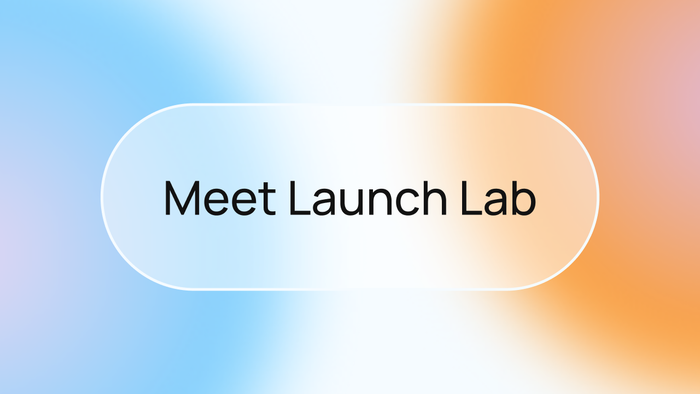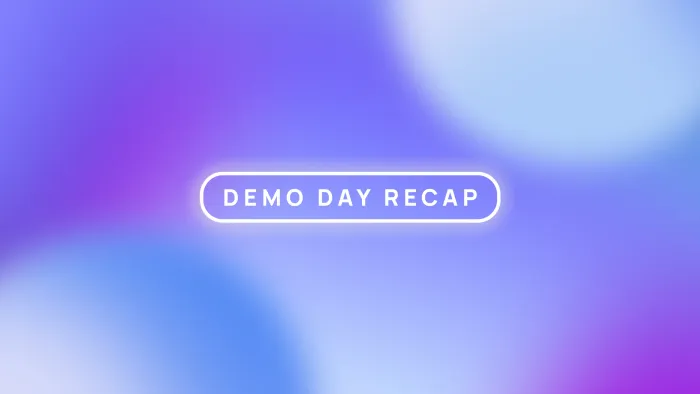No-code development platforms are making software development easier (and faster) than ever, and in order to stay competitive, more and more companies are adopting these tools. In our 2024 State of No-code survey, 64% of respondents said they believed it likely that within five years, the majority of human developers will be primarily using no-code solutions to create software.
Choosing the right no-code tool will reduce your time to market and enable you to build an app that your audience loves, all without knowing how to write code. But going with a bad fit can result in surprise functionality limitations and a longer, slower journey to market.
Which no-code platform is right for you, and how do you choose?
Picking a solution isn’t easy, but this buyer’s guide can help. We’ll introduce you to the most important factors to consider, according to real no-code users, and show you how 23 of today’s leading no-code solutions rank on each one.
How to use this buyer’s guide
We made this guide for people who know they want a no-code solution for building apps and/or websites, but haven’t finished considering options yet. This guide addresses 23 of the most popular no-code platforms available, and they all have their own pitch as to why they’re the best. (Full disclosure: We do, too.) It helps to pare down the options by articulating what’s most important to you in a solution.
This buyer’s guide will help you understand various factors that other people in your position have said are important when considering no-code platforms. We’ve also scored 23 popular no-code solutions on all 11 of these factors to give you an idea of how they generally perform in each area.
The 11 key factors to consider in a no-code platform
In the summer of 2024, we surveyed more than 350 no-code developers to learn how important various features and attributes of no-code solutions are to them. Survey respondents rated these factors on a scale from one to five, with one being “not important at all” and five being “extremely important.” The survey also let respondents add their own additional important factors.
Survey responses revealed 11 factors that no-code platform users believe matter when choosing a solution. Click each one to jump to that section.
- Use-case versatility: The breadth of use cases the tool is known to excel at
- Full-stack coverage: The level of control the platform gives you over design, data, and logic
- Performance: The overall reliability of the platform’s uptime, as well as how the platform’s company communicates during outages
- Ecosystem quality: The quantity, quality, and accessibility of third-party plugins, integrations, partnerships, and agencies
- Cost: The price you pay, the associated costs, and the degree to which you can use the tool for free
- Customizability: The tool’s innate flexibility and extensibility when it comes to adding new capabilities and functionality to your app
- Compliance: The standard(s) that the tool meets
- Code ownership: The amount of your app that you can export from the platform
- Learning curve: The speed at which you can reasonably expect to start building your app on the platform
- Education and documentation: The quality of materials the company makes available to help you get the most out of the platform
- Community: The presence and activity level of real people (both company employees and other users) available to help you use and understand the tool
However, the most important factor of all to consider when choosing a solution is you. We recommend using this guide as a starting point for creating your own decision criteria. You can reorder, contract, or expand this list of factors in a way that fits your needs best, or start your own list from scratch. When it comes to grading options on factors, you can use our rubric or create your own.
We scored 23 no-code platforms on these factors
After learning which factors were most important, we created a five-point scale for grading how well today’s most popular no-code solutions perform on each factor. As we go through the factors in this buyer’s guide, we’ll show how 23 popular options stack up against each other. Each tool receives a 1–5 score for that factor, with five being the best score possible.
We’ve also assigned each tool an overall score. This is a weighted average of the scores across all factors, with more important factors (according to survey respondents) receiving more weight. For example, Bubble’s perfect score of 5 on full-stack coverage counts more toward our overall score than our 5 on community. Likewise, a low score on ecosystem quality hurts a tool’s final score more than a low score on learning curve.
The tools we evaluated are ranked below by overall score.
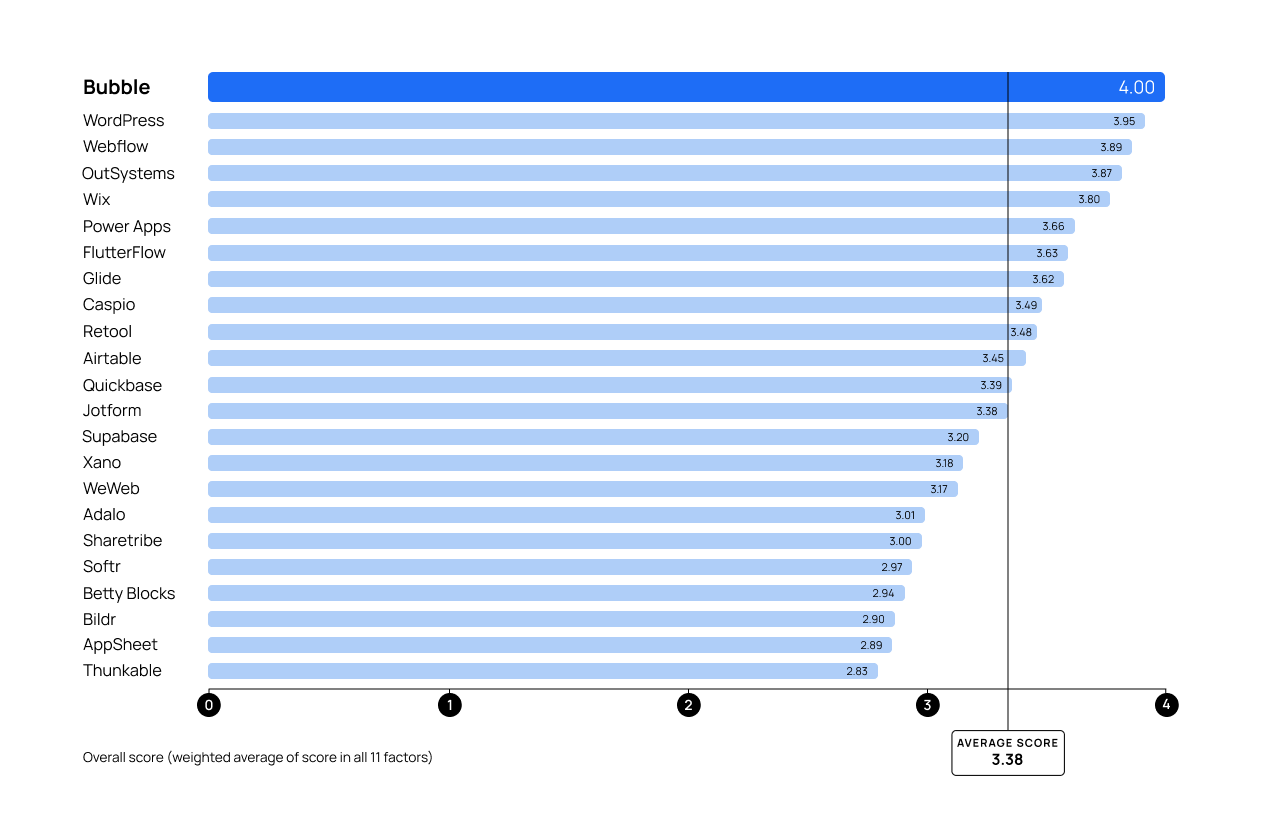
“Hang on,” you might ask. “Why are some of the most popular tools in the middle of the pack?” Good question. There are some widely used tools here that didn’t score as high as you might expect. But remember: We’re evaluating them on the basis of what you can build without writing code. Although Supabase and FlutterFlow are really popular in the app development community, you’ll still need to write some code if you want to build something remarkable with them. Since we’re looking at these tools through a no-code lens, they scored lower in some areas.
This ranking also brings up an important point to keep in mind as you evaluate no-code options: No single solution that scores perfectly on every factor (yet). That’s why it’s important to pick a tool with the strengths and capabilities most relevant to you. If you’re looking for an all-in-one platform, Bubble is the way to go — but if you’re looking for a point solution to solve a specific problem, one of these other options might be better tailored to your needs.
1. Use-case versatility: How diversely is the platform used in the market?
Some no-code tools are deployed in a wide variety of use cases — others have a reputation for being great at doing a narrower set of things. It’s important to consider the range of ways the market uses a given tool when you’re choosing a no-code platform.
We graded these tools based on two aspects of versatility: the kinds of apps people make with them and the industries in which they tend to be used.
Versatility across app types
This is the breadth of types of apps a platform is known to be able to build. A no-code solution with high use-case versatility across app types is used to build all sorts of applications, like CMS tools, productivity tools, e-commerce marketplaces, social networks, etc.
However, a solution with lower perceived versatility in this area tends to be used for a narrower set of applications. For example, Jotform is mostly known and used as a no-code form builder, and AppSheet has an excellent reputation for enterprise-grade business process automation.
Versatility across industries
No-code platforms tend to iterate on their tools in ways that serve their user bases. If a platform is adopted by a wide range of industries, then it will usually focus on features and improvements that are useful in many industry contexts. Likewise, when only a few industries adopt a platform, it tends to develop features and capabilities specifically for those industries.
No-code platforms, ranked on use-case versatility
Of the 23 tools we reviewed, only Bubble is known to have broad usage across industries and across app types. The majority of platforms (52%) are known to be versatile in only one of these two aspects. The average score across tools in this area is 3.3/5.
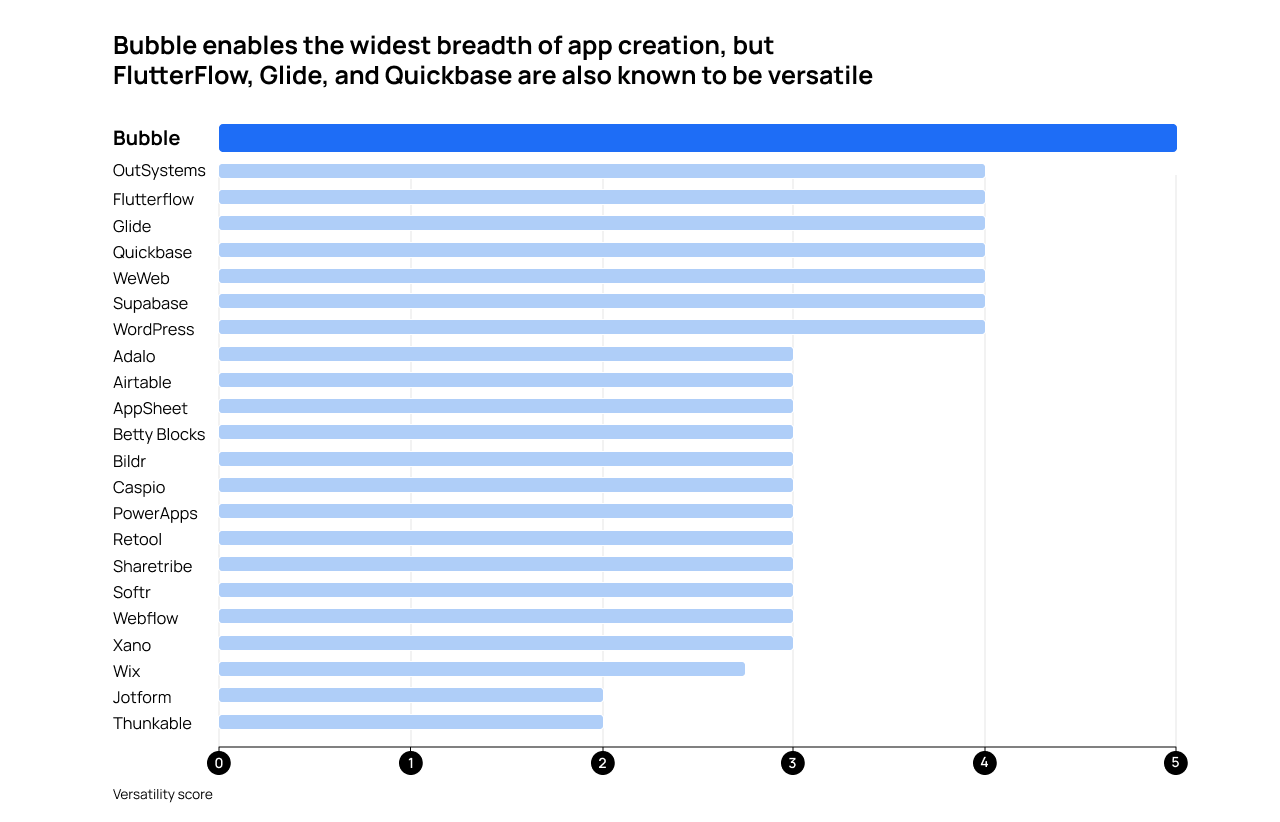
What these scores mean: Tools reputed to be versatile across app types and industries received the highest scores. Tools known for one type of versatility but not the other scored in the middle, while tools known for a very narrow set of use cases (or tools that have yet to gain much of a reputation at all) scored lowest.
| Score | Criteria |
|---|---|
| 1 | Not particularly well-known or well-perceived by the market for any use cases |
| 2 | Narrow set of use cases as perceived by the market |
| 3 | Use-case versatility across app types or industries, but not both. |
| 4 | Use-case versatility across either app types or industries, with some use-case versatility in the other category |
| 5 | Shown to be proficiently versatile across both app types and industries |
2. Full-stack coverage: Does the no-code platform handle design, data, and logic?
Any app you build has three basic components: design, data, and logic.
Design is the frontend. It’s what people see when they interact with the app, like screen layouts, buttons, fonts, and colors. A no-code platform with design capabilities will usually give you a drag-and-drop editor for building and customizing your app’s user interface.
Data is the backend. It’s the information your app processes in order to do its job. Your app’s database houses each user’s account information as well as the dynamic information they access using the app itself, like product specs, GPS coordinates, or messages sent to and from other users. No-code platforms that handle data will allow you to create and structure your app’s database the way you want.
Logic is what ties data and design together. It’s the cause and effect of your app that makes things happen when people click buttons, adjust settings, and publish updates. Platforms with logic capabilities let you designate events that trigger app responses and build automation workflows.
While some developers prefer to handle all three of these components in a single full-stack solution, others take a piecemeal approach, using different tools to address different areas of the stack. If you’re building a standalone app, you’ll need access to all three of these capabilities one way or another.
That’s why this factor is so important when it comes to picking a no-code platform. If you don’t choose a full-stack option, you’ll need to integrate your main platform with other solutions, which complicates the development process and introduces new potential failure points. Be sure to research the costs and risks associated with those extra tools if you go down this route.
No-code platforms, ranked on stack coverage
Of the 23 no-code solutions we reviewed, nine give users access to handle design, data, and logic within the platform.
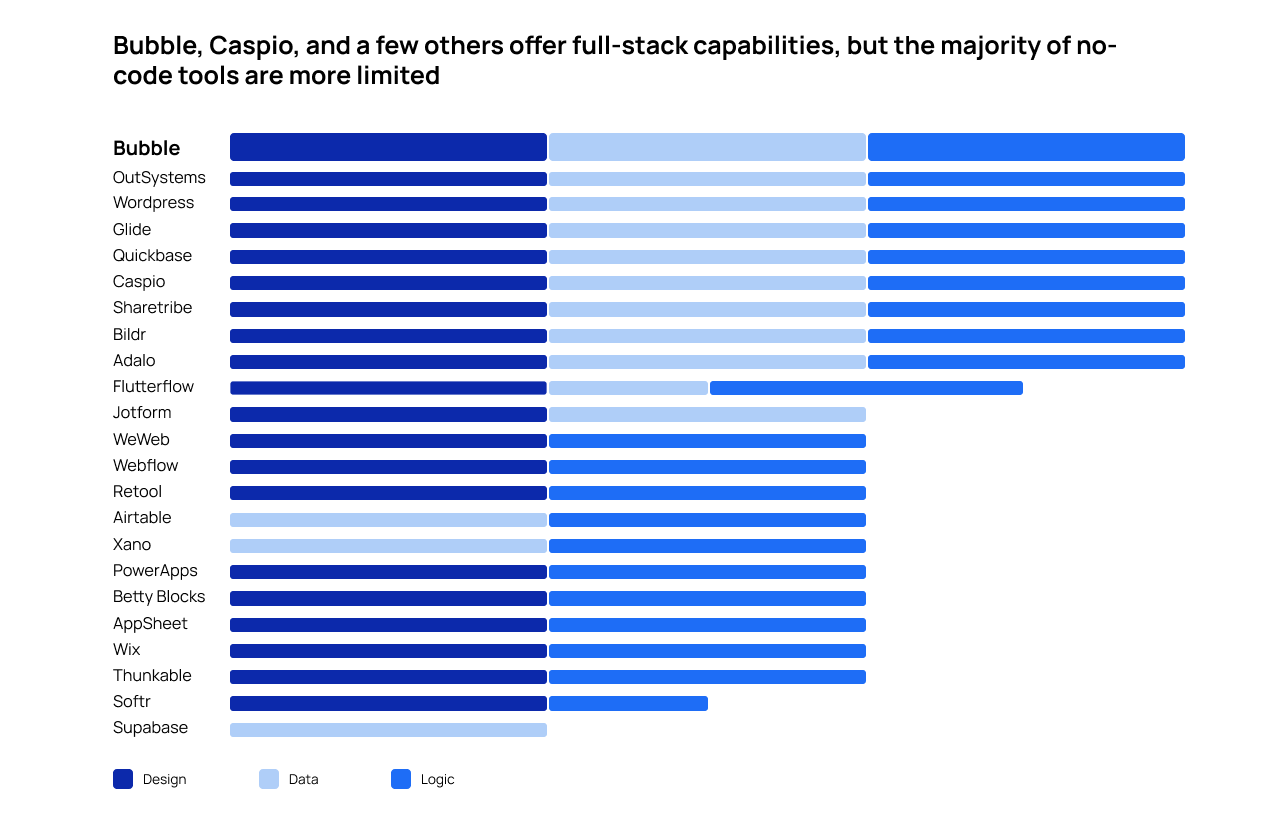
What these scores mean: To translate coverage of these three areas to a five-point scale, we gave tools the full five points if they covered all three, three points if they covered two, and one point if they covered only one.
| Score | Criteria |
|---|---|
| 1 | Capabilities in one area: design, data, or logic |
| 2 | Capabilities in one area, gives user limited access to another |
| 3 | Capabilities in two areas |
| 4 | Capabilities in two areas, gives user limited access to the third |
| 5 | Full-stack: Capabilities in design, data, and logic |
A few tools provide the user with limited access to a given area and received scores of 2 or 4. For example, FlutterFlow doesn’t directly cover data and requires a separate tool for backend work — but you can build your own data schema within FlutterFlow. Because FlutterFlow gives you full control of design and logic but only partial control of data, we gave it a score of 4. It’s not quite full-stack, but it’s closer to full-stack than a tool that doesn’t have any data structuring capabilities at all.
3. Performance: How reliable is the no-code platform?
If you’re building an app on another platform, you need to know if you can count on it to stay online. “Performance” is a difficult term to define, but in general, you want to look for three things: outage frequency, scalability, and communication during downtime.
Communication during downtime
Think about the last time a storm knocked the power out at your home. Did you have an idea when things would be back to normal? If you had to leave home to work from a café, did you have a means of checking the status? Were you notified when everything was back online?
Ideally, your power company would have made all of this information available to you throughout the process. It’s bad enough to lose power, but a lack of communication can leave you feeling even more in the dark — and more frustrated by the disruption.
The same principle applies to no-code development solutions. How a company communicates with its users during downtime is a key factor to consider when you’re choosing a platform to build your app on. The more prompt and transparent their communication, the better. Clear communication helps you understand your situation, and it also helps you keep your own users in the know.
When assessing a no-code vendor, check if they have a status page on their website. If so, that’s a good sign. Browsing their community forum space to see how the company responds to incident report threads can be helpful on this front, too.
Outage frequency
If your app is running on a third-party platform, then when the platform goes down, so does your app. Outages can frustrate users, back up customer support lines, and cost you revenue and accounts.
That’s why you’ll want to look into a platform’s history of uptime and outages before making the call. Some companies make their outage history public, but for other companies, you might need to do some digging. Searching subreddits and review sites can give you an idea of user sentiment on this front — as well as an anecdotal view of how often outages occur.
Scalability
If you’re building an app whose usage could rapidly expand, you need a no-code platform that can handle it. This is especially true for startups. Imagine the feeling of a marketing campaign doing phenomenally well, or getting a surprise shoutout from a public figure on social media — only for the rush of new users to break your app!
If you’re building a tool with relatively predictable usage, or you’re just a hobbyist, this may not be a big concern for you. But if you’re building something that has the potential to grow rapidly (a good problem to have!), you should investigate the platform’s history of performance during usage spikes. If it has an active community, asking for customer stories on the company forums or subreddit is a good place to start on this.
No-code platforms, ranked on performance
Just over half of the tools we assessed scored 4 or higher, with the average score being 3.5/5. Overall, this is good news: Most of the popular no-code solutions have infrequent outages. The biggest differentiator is how they communicate during these outages.
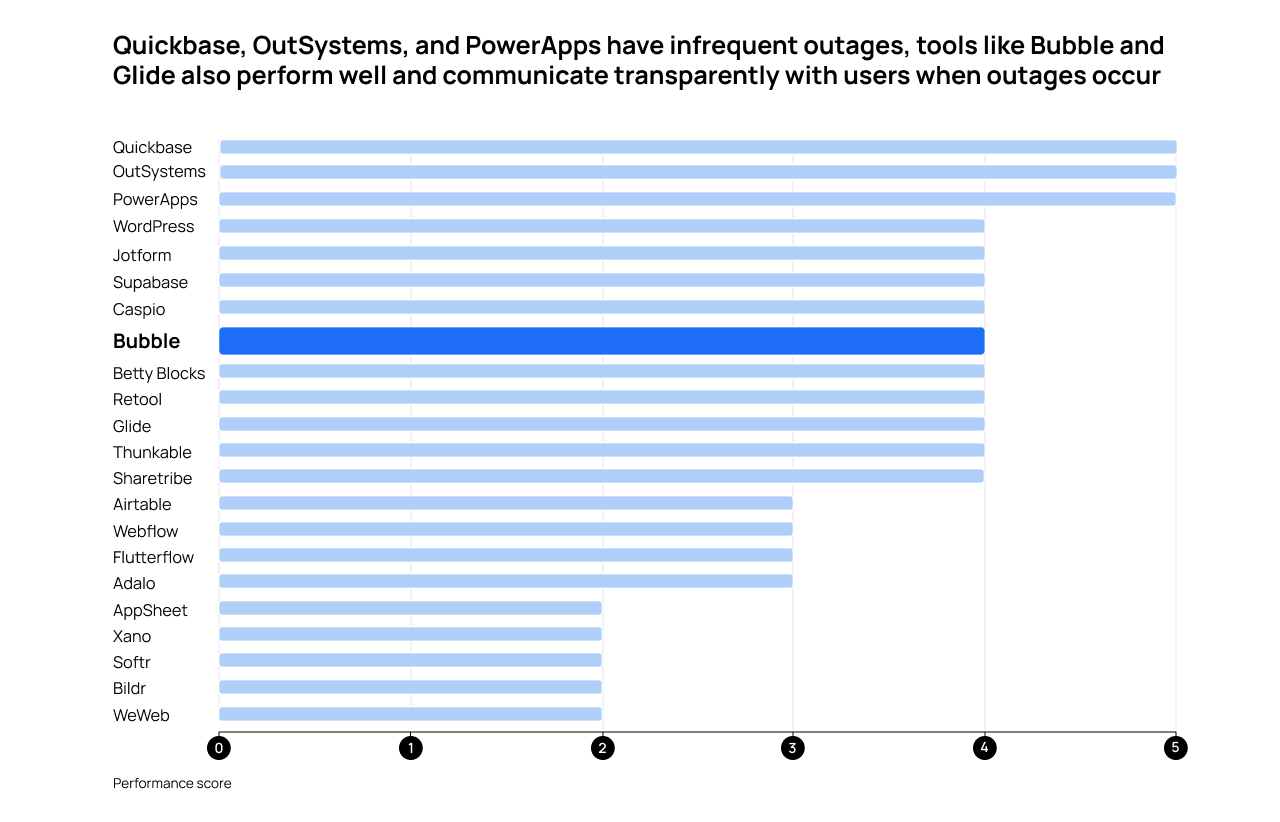
What these scores mean: Each tool was reviewed for its history of outages and the company’s communication surrounding outages. Low outage frequency and demonstrated transparency contributed positively to a tool’s score.
| Score | Criteria |
|---|---|
| 1 | Frequent outages |
| 2 | Outages scale with user growth and/or company has no status page |
| 3 | Infrequent outages, but communicated with limited transparency to the user or sporadic outages, but quickly and transparently addressed |
| 4 | Infrequent outages, with any that do occur quickly and transparently addressed |
| 5 | Rare outages |
4. Ecosystem quality: How well does the no-code platform connect with third parties?
You shouldn’t build an app in a vacuum. An ideal no-code solution has a thriving ecosystem of third-party plugins, templates, agencies, and partnerships. The better-connected your platform is out of the box, the less heavy lifting you’ll have to do to make it work with the rest of your systems. Plus, it’s a huge green flag if people (or entire companies) are making their living on top of a platform — it indicates that the platform is widely used and widely trusted.
One thing that’s important to note on this front: While a platform may support third-party services, they may not be easy to use. Some integrations are more seamless than others, some platforms make plugin installation easier than others, etc. As you assess options on ecosystem quality, be sure to look into the experiences other developers have had when it comes to leveraging third-party services.
Integrations
Unless you’re starting from absolute scratch, you probably already know which other systems you need your platform to connect with. Check every option’s integrations list to see how well it already connects with the software you’ll be using in tandem, and if a key integration isn’t supported, ask around the development community to see how difficult it is to rig the necessary integrations yourself.
Note: Bubble facilitates integrations with third-party tools via plugins — which brings us to the next ecosystem element to consider.
Plugins
If a no-code platform has a quality ecosystem, then there are probably a lot of wheels you won’t need to reinvent. When considering options, check if they support third-party plugins, and get an idea of how easy each platform makes it for the development community to create these extensions. If it’s easy to create and share helpful tools with other users, you’re more likely to save time by leveraging the work of developers who have solved common problems before you.
Third-party templates
While several no-code app builders include pre-built starter templates, it’s unlikely that any vendor will have a ready-to-go template for every kind of screen, data configuration, or workflow its users frequently create.
That’s why some providers allow third parties to make their own templates available to other users. If a solution takes this route, then you can build on those existing templates instead of starting from square one.
Agencies and experts
Some platforms are so widely used that a host of expert-level agencies and freelancers have built their businesses on developing with the tool. When this is the case, you have the option to contract extra help when you need it — whether it’s to expedite production, knock out isolated projects, or handle issues outside your team’s set of expertise.
The most sophisticated no-code platform ecosystems have browsable agency and expert networks that allow users to find agencies based on their specific budget, project, language, location, and other factors.
Strategic partnerships
It’s one thing if a platform supports seamless integrations with other key systems. It’s another thing entirely when the two parties have a public-facing partnership. This is usually a good indicator that both parties are sharing information with each other related to forthcoming updates and changes — which means they can both plan to keep their products compatible in the long term.
No-code platforms, ranked on ecosystem quality
More than 85% of the no-code tools we reviewed support a robust set of third-party services, with an average score of 3.6/5. Plus, over 50% of the tools sport strong business partnerships.
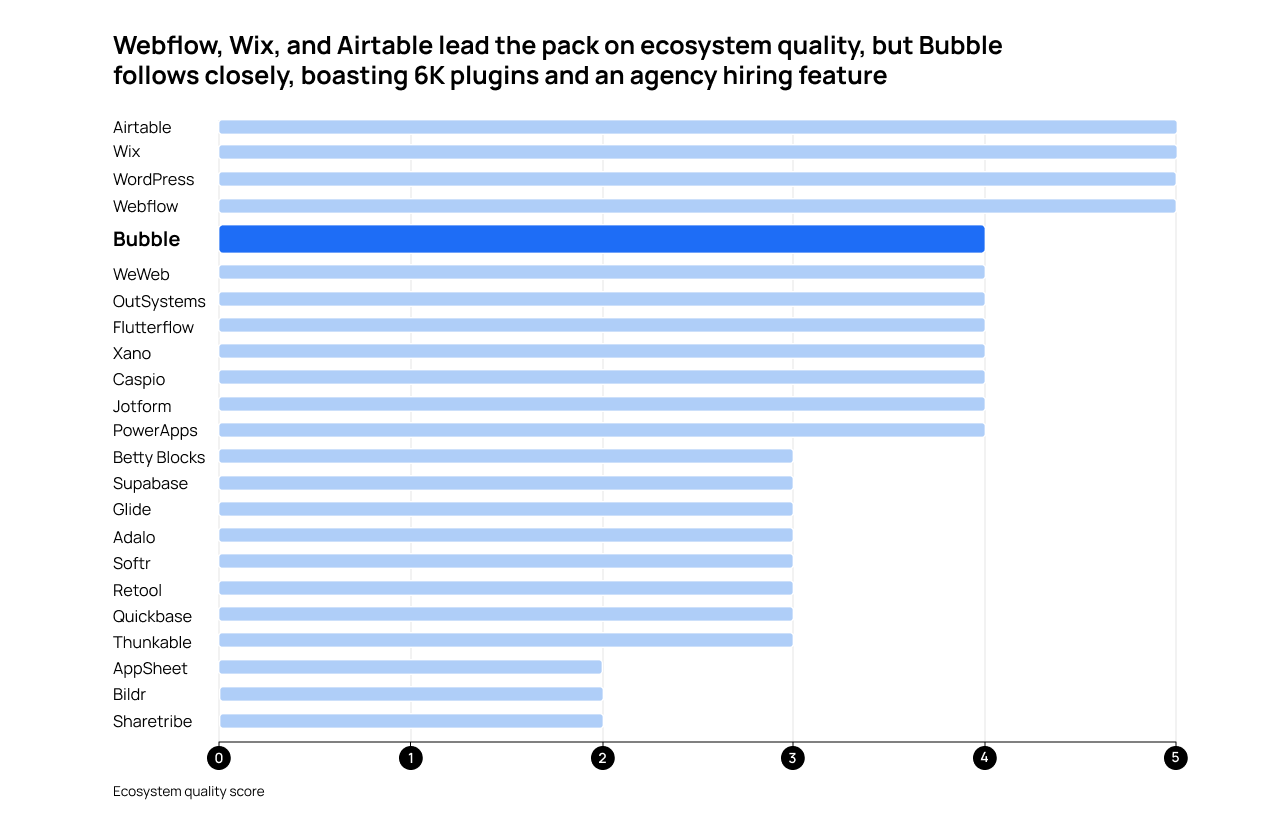
What these scores mean: For this part of the rubric, “third-party services” refers to integrations, plugins, templates, and agencies. A tool is considered to have “minimal” third-party services if it only supports two or fewer of these types.
| Score | Criteria |
|---|---|
| 1 | Minimal third-party services that are challenging to use |
| 2 | Minimal third-party services, but they’re easier to use |
| 3 | Robust third-party services, but they’re challenging to use |
| 4 | Strong strategic partnerships; robust third-party services, but not perfectly seamless |
| 5 | Strong strategic partnerships; robust third-party services that are easy to use |
5. Cost: How much will you pay for the no-code platform?
Cost is one of the more difficult factors to score no-code platforms on, because when it comes to cost, the lowest initial price isn’t necessarily the best one. When weighing your no-code options, be sure to consider the pricing structure and the total cost of ownership of each tool you’re assessing.
Price
The most obvious component of cost is the price you pay to access the tool. This is what you see on a given vendor’s pricing page.
Pricing varies widely in this market, as some tools are intended for large businesses with big IT budgets while others are aimed at independent developers and bootstrapped startups.
Pricing structure
Beyond the starting price, you should also consider how your price will be calculated over time. All 23 of the tools we graded for this guide use the SaaS subscription model, but different companies price access to their tools based on different metrics.
For example, some no-code platforms charge based on how many users access the tool (you pay for the number of “seats” you occupy), whereas other platforms charge based on the amount of workload you put on the tool. Some companies’ pricing structure is a hybrid of both. It’s important to keep pricing structure in mind as you calculate the total cost of ownership, because the way you grow may affect the way your monthly tech expenses grow, too.
A word to the wise: It’s common for vendors who bill by the seat to list their plan prices as the amount per seat you pay. If this is the case, keep an eye out for any required minimums. A monthly price of $10/seat may sound like a great deal for a small team, but if you’re required to purchase a minimum of 50 seats, you’ll end up paying $500/month — and most of that will be for seats you’ll never use.
Free access
There’s also the question of when you start paying. Each of the 23 tools we researched offer some degree of free access at the beginning, but the conditions and limitations applied to the free period span quite a range:
- Some (like Airtable and Thunkable) have lightweight free plans for small teams and projects.
- Some (like Quickbase) have a limited-time free trial period.
- Some (like Appsheet, and Bubble) allow indefinite free use before deployment.
If you’re building a sophisticated app for even a modestly-sized user base, you’ll likely end up on a paid plan with your no-code development tool. The important thing to keep in mind when considering free access is when those payments are going to kick in during the process of creating your app.
Overage costs
If you exceed the limits of your plan, you will often be subject to paying extra. This isn’t a bad thing! Just be sure to account for overage costs as you compare options.
Not every company deals with overages in the same way. Some vendors will warn you when you’re reaching your limit, and some will even give you the option to cap your usage once you reach the limit, avoiding overages entirely. (At Bubble, we do both.)
Finding overage cost information isn’t always easy. The first place to check is the vendor’s pricing page — be sure to hover over the limits listed with various plans, as sometimes this information is in the tooltips! If you don’t find it there, reaching out to the company directly or browsing community forums and subreddits will usually give you an idea of how much overages can cost.
When it comes to Bubble’s pricing, we know that overages are usually a sign of a good thing: You’ve had a spike in people using your app! We give our users a pay-as-you-go option for dealing with overages:
- First, we send you an alert as you approach your plan’s limit.
- If you choose to allow overages during temporary spikes, you’ll just get charged extra at the end of the month based on how far over your plan’s limit you went.
- And if you anticipate a lot more usage in the long term, you can always upgrade your plan tier to get a bulk discount on all that extra app use in the future.
This way, if your app outgrows your current plan, you can ride the whole wave.
No-code platforms, ranked on cost score
Of the 23 tools we reviewed, 18 allow you to create an app for free and deploy it on a custom domain for less than $50/month. A few outliers (AppSheet, Wordpress, and Thunkable) even have plans for deploying apps on custom domains for less than $10/month.
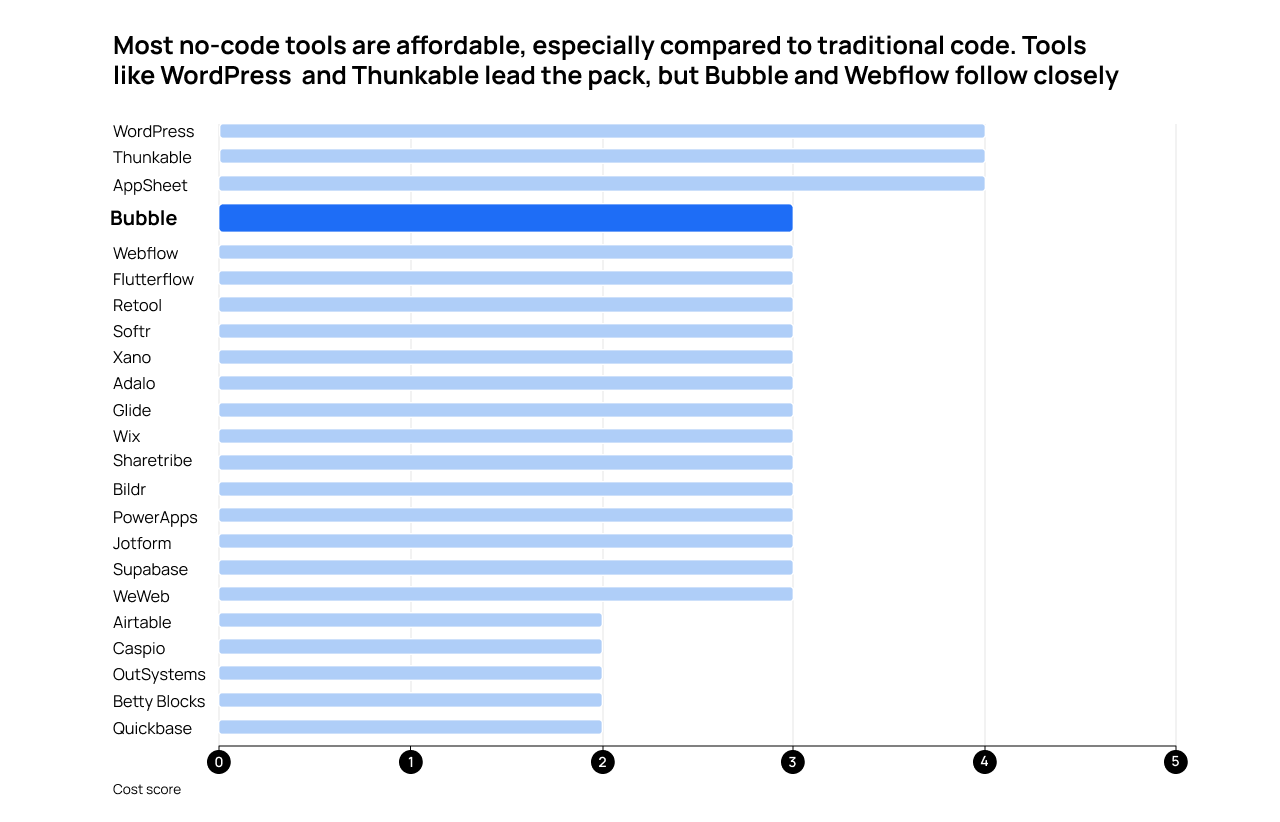
What these scores mean: In general, higher scores mean lower costs. These scores account for two aspects of pricing: whether or not a tool includes an indefinite free build tier, and their lowest monthly price for deploying an app on a custom domain. As mentioned above, there are many more factors to keep in mind when considering the cost of a tool — but their impact will vary from use case to use case. Be sure to do your own cost calculations when choosing a no-code solution.
| Score | Criteria |
|---|---|
| 1 | No free tier |
| 2 | Free tier, deployment on custom domain costs more than $50 per month |
| 3 | Free tier, deployment on custom domain costs less than $50 per month |
| 4 | Free tier, deployment on custom domain costs less than $10 per month |
| 5 | Free deployment on custom domain |
6. Customizability: Does the no-code platform let you build what you want?
It’s important that whatever no-code platform you use to build your app is capable of building your app. This brings up the question of how customizable the platform you choose is — both via manual building and AI assistance.
Building beyond frontend templates
Most no-code platforms come with a library of templates to work with from the start. These might be screen templates, database templates, or even generic starter applications. These are useful for getting started quickly, but when it comes to creating outside of templates, some platforms give developers more room for customization than others.
When you’re looking at no-code options, check if the tools you’re considering will let you make what you have in mind. Does the tool give you a blank canvas option, or are you locked into a limited set of paint-by-numbers templates?
Adding new functionality
No-code platforms will also come with ready-to-go logic and databases to use. For some creators, these out-of-the-box workflows and configurations are more than enough to build what they need. But if you want to create new or custom functionality for your app, you’ll need to use a platform that allows you to do so.
Depending on the platform you use, this may require integrating with other automation and data systems and/or writing your own code. It’s a smart idea to check what range of functionality is already available to play with in the builder as well as ask around the development community to see what others’ experience has been like with adding new functionality to their apps.
Generative AI capabilities
As generative AI matures, more no-code app builders are leveraging it to help people create functionality using AI prompts rather than manually designing it themselves. Some no-code app builders are leveraging it to help generate logic and data schema based on text prompts. Others are building AI-powered copilots, which help people accomplish tasks faster, or get them unstuck.
This is especially helpful when it comes to customization in a no-code environment. Without generative AI, most developers need to start writing code in order to add significant new functionality to their tools. However, as AI becomes more sophisticated (and as developers become more experienced working with AI), it can take on more of the heavy lifting — which significantly expedites the development process.
No-code platforms, ranked on customizability
More than three-quarters of the 23 tools we reviewed allow users to customize functionality. Eight of these tools even support some degree of AI-generated logic and data schema. The average score in this area is 3.1/5.
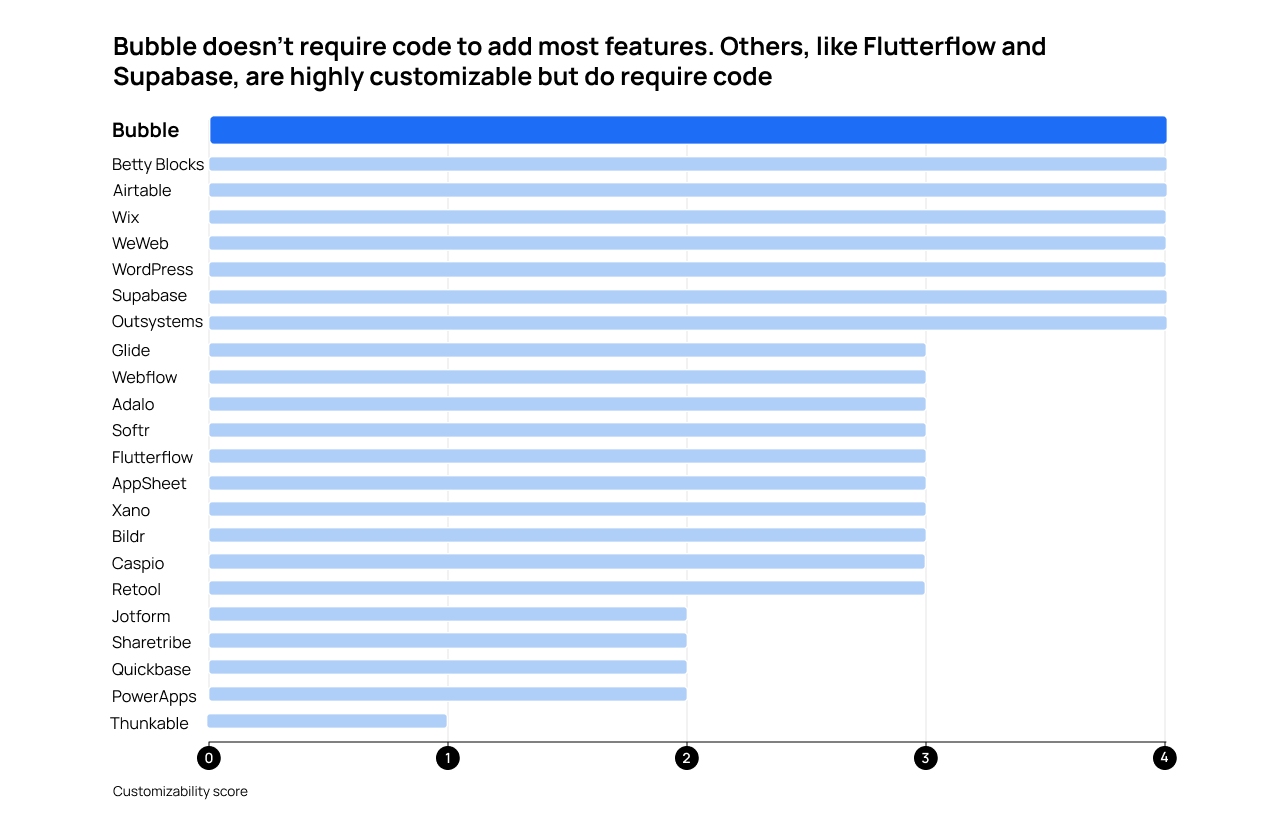
What these scores mean: We scored these tools based on two general aspects of customizability. First, we looked at how much room the tool gives users for customizing the frontend and backend beyond provided templates. Second, we accounted for the degree to which new design and functionality could be created using generative AI. Tools that gave users the most freedom and the most AI support got higher scores, while tools that give users limited customization options (or whose customization is not accessible to non-technical users) scored lower.
| Score | Criteria |
|---|---|
| 1 | Minimal ability to customize frontend, minimal ability to add new functionality, high level of difficulty to build beyond templates |
| 2 | Customizable frontend, minimal ability to add new functionality, limited generative AI assistance |
| 3 | Customizable frontend, open to adding new functionality, robust frontend AI use cases |
| 4 | Everything from 3, plus AI-generated logic and data schema |
| 5 | Everything from 4, plus conversational editing that allows for entire AI-generated apps |
7. Compliance: What security standards does the no-code solution adhere to?
Data security is becoming increasingly important in business today — if you’re building an app on someone else’s software, you need to know how secure their software is (or isn’t). This is why one of the important consideration factors that arose in our survey concerned out-of-the-box compliance standards. Developers want to know what security frameworks the platforms they’re building tools on already comply with.
Not every app needs to comply with every single security standard out there, but some markets demand higher security standards than others. Using a platform with a high degree of native compliance keeps your app (and your user base) more secure, and it also helps you sell into more security-sensitive markets (e.g., healthcare, government, and finance).
No-code platforms, ranked on native compliance
To grade tools in this category, we made a list of compliance frameworks in ascending order of stringency. In general, no-code platforms did well here: 17 of the tools we reviewed are compliant with at least ISO 27001 or SOC 2, and the average score in this area is 3.7/5.
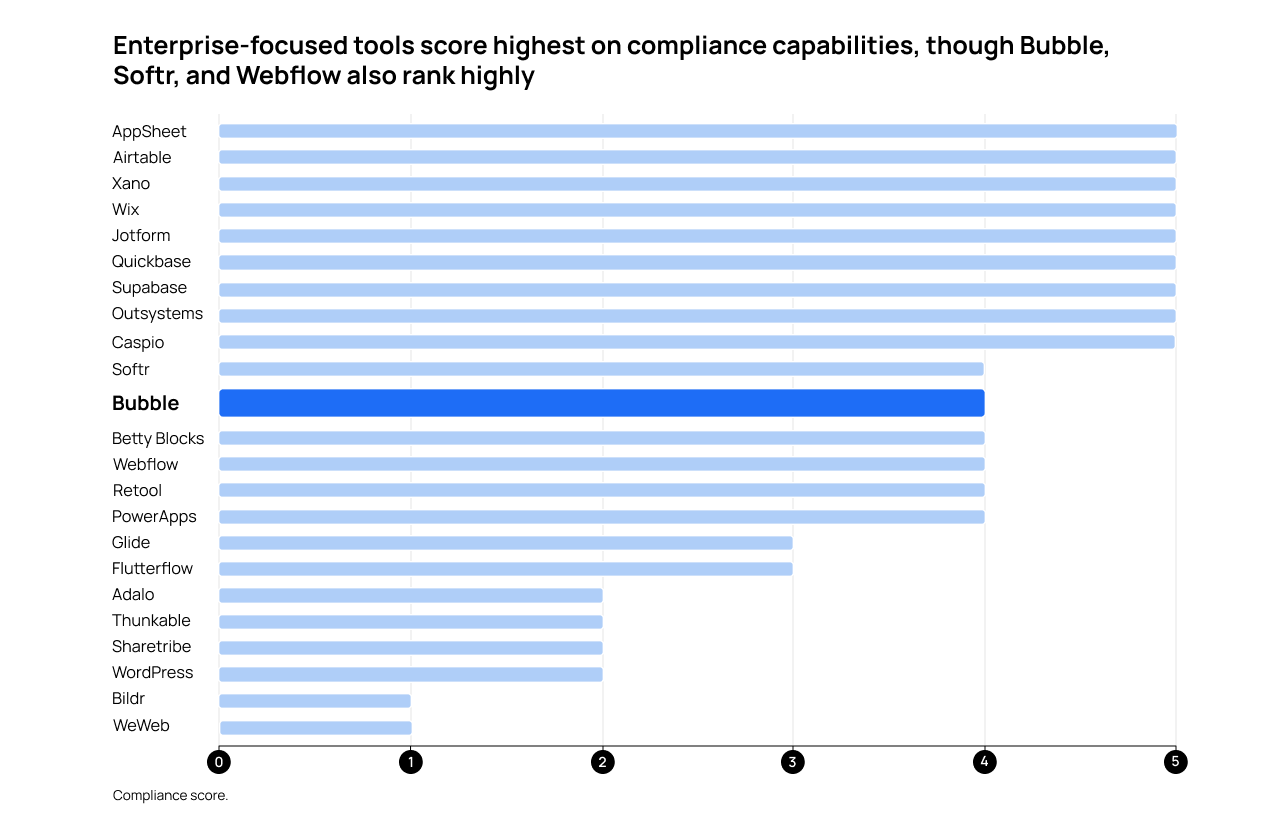
What these scores mean: We looked up each tool’s certification status across various frameworks, particularly SOC 2 types I and II, ISO 27001, and HIPAA. The higher compliance standards a tool met, the higher their score.
| Score | Criteria |
|---|---|
| 1 | No stated native compliance certifications |
| 2 | No native compliance certifications, but either 1) can be made compliant with plugins or 2) gives instructions for hosted apps to become compliant by themselves |
| 3 | SOC 2 Type I compliant |
| 4 | SOC 2 Type II compliant or ISO 27001 compliant |
| 5 | SOC 2 Type II compliant and HIPAA compliant |
8. Code ownership: How much of your app can you move off the platform?
When you write your own code from scratch, you can do whatever you want with it. But when you’re building an app on a no-code builder, the builder’s company creates and stores the underlying code for you. The software you build on the platform is still yours — but the process (and ease!) of moving that software off the platform varies from company to company.
Some no-code platforms allow you to export everything you’ve built. Others allow you to export some pieces, but not the whole app. A few of the options don’t allow you to export anything at all.
Code ownership is a trade-off. For many, the benefits of a given platform far outweigh any risks of potential lock-in. When you’re considering different no-code options, this is an important factor to consider for a few reasons.
Switching concerns
There are a lot of no-code options out there today. Some of them will keep growing and others may not be here tomorrow. Plus, you have to think about your own operation: Although no-code will likely become an even more ubiquitous part of the development process, someday you may decide that you want to move away from your no-code platform. In the event that another option (whether traditional code or another no-code platform) draws you away in the future, you’ll want to take as much of what you will have built with you when you switch.
Not every platform makes it possible to export your app and take it elsewhere — and many of the platforms that do allow this don’t export code in actionable formats. So before choosing a no-code option, think about how much you’ll want to take with you if you should leave it in the future.
Intellectual property concerns
Then there’s the issue of IP. While the things you create on a no-code platform aren’t open source or public domain, you still need to deal with the question: How much of your app can you claim as your intellectual property?
Of course, the best way to get an exact understanding of this is to read a vendor’s terms and conditions (or better yet, have a lawyer read it).
In Bubble’s case, you own your data. That includes both your app’s design and any data uploaded by your users (based on the agreement you have with them). On the other hand, Bubble retains ownership of the underlying code that powers your app. Think of it like this: Microsoft owns the software Microsoft Word, but doesn’t claim ownership over the documents you create with it.
Code review concerns
If you’re raising funding for a tech startup, there’s the possibility that VCs will want to see your code base as part of their technical audit process. However, not every no-code platform supports full code exports. If you choose a platform that doesn’t export code, that’s not an insurmountable hurdle — many founders have secured funding in that exact situation. You’ll want to prepare an alternative means for investors to review your product.
MVP implementation concerns
Minimum viable product (MVP) development is a popular no-code use case. Some no-code platforms (especially the less powerful ones) allow developers to rapidly create a functioning proof of concept, but the intent is to build the final product elsewhere. Code ownership is important here too — if you can’t export your MVP as code, then you’ll have to start all over when you build your final product.
Exporting (usable) data and code
When discussing code ownership, you want to ask three questions:
- Can you export your app data? Your app’s backend database houses all manner of information about users, customers, products, and more. If you should move away from the no-code solution you used to build the app, you’ll likely want to take all that data with you for the app’s next incarnation.
- Can you export your app code? Even if you don’t write a single line of code when you build your app, its frontend design and logic still come down to a programming language. If you want to preserve the visuals and functionality of your app when you switch away from a no-code platform without starting over, you’ll need to export your app as code to use elsewhere.
- How can your exports be used? Even if you can export your data and code, there’s the question of what you can do with it. Some vendors will allow you to export your data and code in various programming languages and formats, whereas some only export materials in ways that limit how you can use it elsewhere.
Of course, if you choose the right no-code solution, you may never need to worry about exporting your app and taking it elsewhere. Still, it’s good to consider now.
No-code platforms, ranked on code ownership
Of the 23 tools we reviewed, six allow users to export their data and code in flexible formats. Furthermore, 20 allow them to export their databases to use elsewhere. The average score in this area across all vendors is 3.3/5.
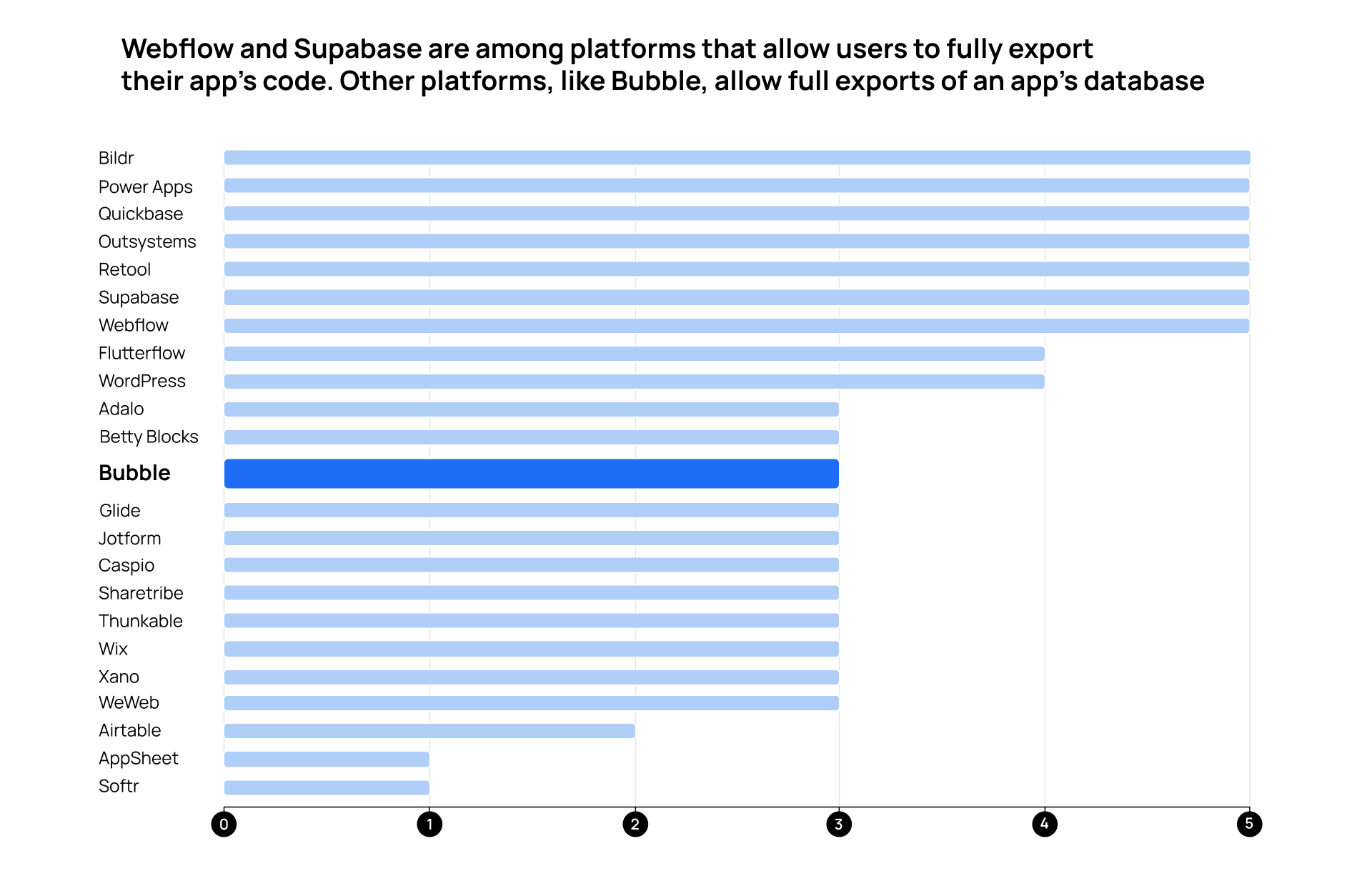
What these scores mean: We looked at each vendor while asking the three questions mentioned earlier. Platforms that allow you to export all your data and code in usable formats scored highest, while platforms that don’t export anything scored lowest.
| Score | Criteria |
|---|---|
| 1 | No exports supported |
| 2 | Allows partial data exports |
| 3 | Exports data, but not code |
| 4 | Exports data and code, but in limited languages and formats |
| 5 | Exports all data and code |
9. Learning curve: How quickly can you begin creating apps on the platform?
Some tools are easier to get the hang of than others, which means the platform’s learning curve will affect how productive you can be at the very beginning. Before you pick a no-code option, consider the amount of time it will reasonably take to begin building your first app.
In general, the more powerful a tool is, the more time it’ll take to learn. For example, piloting a plane takes a lot longer to learn than riding a bike, but a plane can take you farther and faster than any bike can. A steeper learning curve isn’t a sign of an inferior tool — it just requires a greater time investment to realize greater rewards.
Requisite technical expertise
Some no-code tools are designed for people with absolutely no technical background, while others are made to help proficient developers become more efficient. Even if the tools in the latter category don’t require you to write code, they tend to assume users have some degree of technical know-how.
Prior technical expertise can come into play in several ways. Some platforms require users to learn a new code-free programming language — you’ll need to know Dart in order to use FlutterFlow, for example. Other tools make it clear that familiarity with certain languages ahead of time will speed up the learning process (like how Bildr tells potential users that prior experience with CSS will come in handy).
When researching no-code options, it’s smart to learn what level of technical familiarity the vendor expects users to bring to the table. The company website is a good place to start, but it’s wise to compare vendor statements to unbiased user reviews and community discussions to get the full picture of just how beginner-friendly a tool is.
Time investment
Of course, there’s also the time it takes to learn the tool itself. Setting expectations is key here. Spending a week learning to use a tool you expected to learn in a day is frustrating. But planning to spend a week learning to use a tool that will save you a month’s worth of time every quarter is a terrific deal.
So as you consider all the above factors, make sure to get an idea of how long it’ll take to learn to use a given no-code platform. You can get an idea of how long it takes to start building by checking the vendor’s website, browsing their educational content, and outright asking their developer community for input.
No-code platforms, ranked on learning curve
Of the tools we reviewed, six emerged as easy enough to quickly learn with a small degree of technical expertise. The average score in this area is 2.9/5.
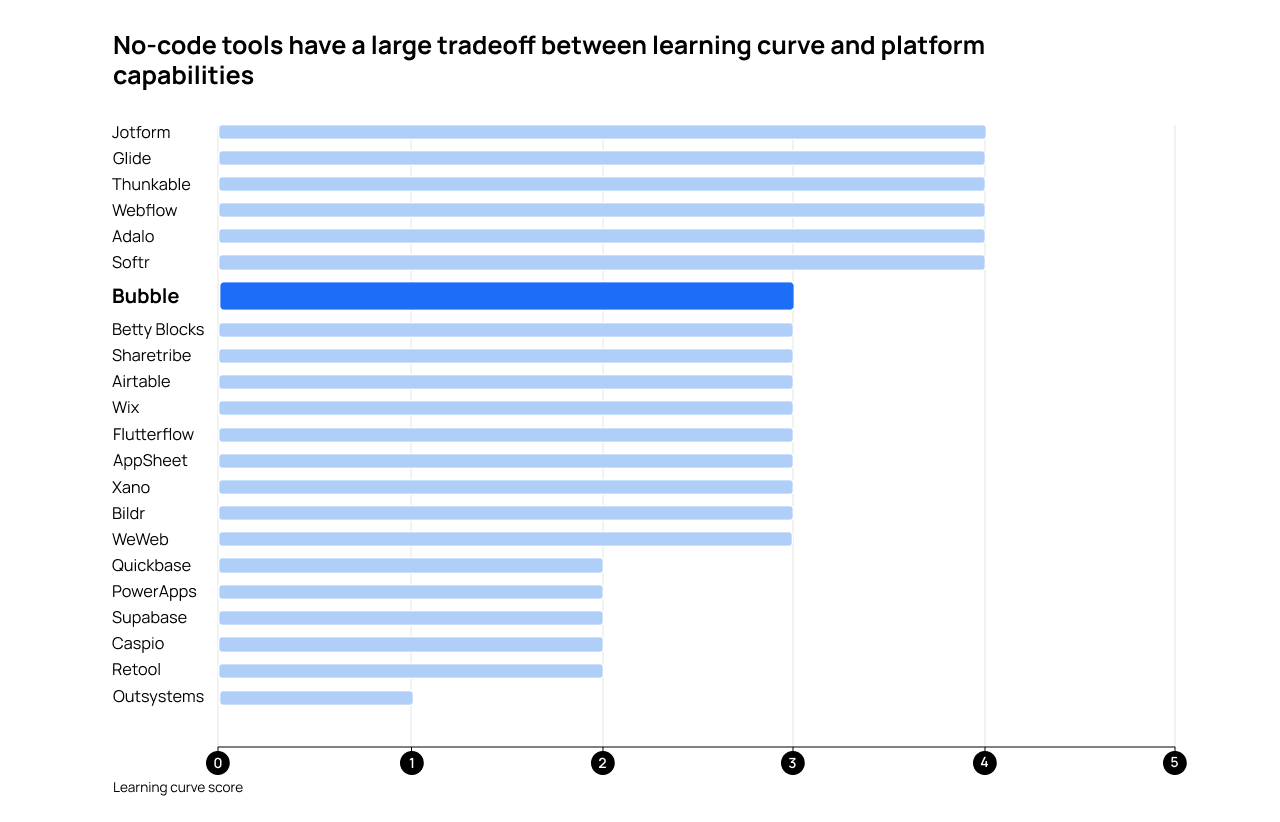
What these scores mean: Ease of use is notoriously difficult to quantify objectively, but we’ve attempted to fairly evaluate each tool based on the requisite technical expertise and time investment it takes to start building apps on it.
| Score | Criteria |
|---|---|
| 1 | Extremely difficult to learn (comparable to learning code), demands significant technical knowledge, extensive time investment |
| 2 | Very difficult to learn, demands strong understanding of logic and some technical familiarity, extensive time investment |
| 3 | Moderately difficult to learn, demands moderate technical familiarity, moderate time investment (courses, tutorials, community support, etc.) |
| 4 | Somewhat easy to learn, demands minimal technical familiarity, allows you to start building on your first day |
| 5 | Extremely easy to learn, no technical familiarity needed, allows you to build something in your first hour |
10. Documentation and education: How helpful are the no-code platform’s training materials?
If you’ve ever attempted to assemble furniture yourself, you understand why this is important. Ideally, your solution should provide you with the materials you need to use it well.
This may manifest as a documentation library, tutorials, certification programs, or any combination of those things. While it’s good to have a variety of educational channels and media to appeal to different types of learners, what’s more important is to look for the following marks of good training materials.
Resources should be easy to navigate
It shouldn’t be hard to find what you need. Navigable documentation and educational materials should allow you to:
- Search for the specific information you know you need
- Browse to find information you didn’t know you needed
- Filter and sort content for relevance, preferred medium, and language
In addition to these self-guided navigation aids, a good educational library will include some form of guided tour that holds your hand through the education process.
Resources should be high quality
When you find the documentation you’re looking for, it needs to actually help you solve the problem at hand. Helpful educational resources will explain how to use the tool in ways that a complete beginner can follow — and should allow seasoned experts to jump to the pertinent information they need without making them wade through remedial material. High-quality resources are also kept up to date with how the product currently works (screenshots in documentation should look like what you see in the actual product, for example).
Resources should be comprehensive
While it’s unreasonable to expect a documentation library to address every single question a user may have, it should cover the major competency domains that users need in order to use the product. The vendor should have general guides for navigating every step of the app development process, each aspect of the app stack the tool covers (design, data, and/or logic), and popular use cases (e.g., building a customer database, creating a product listing, building a checkout process, etc.).
A structured approach to education should be available
While it’s good to have a browsable library of educational content, it’s even more helpful when a company provides an intentionally designed program for learning to use their platform. Such an approach will allow new users to build their understanding of the product progressively, with sequential tutorials that build upon each other.
No-code platforms, ranked on documentation and education
Of the 23 vendors reviewed, only four were found to have documentation and educational libraries that are both high quality and thoroughly comprehensive. The average score across vendors in this area is 3.5/5.
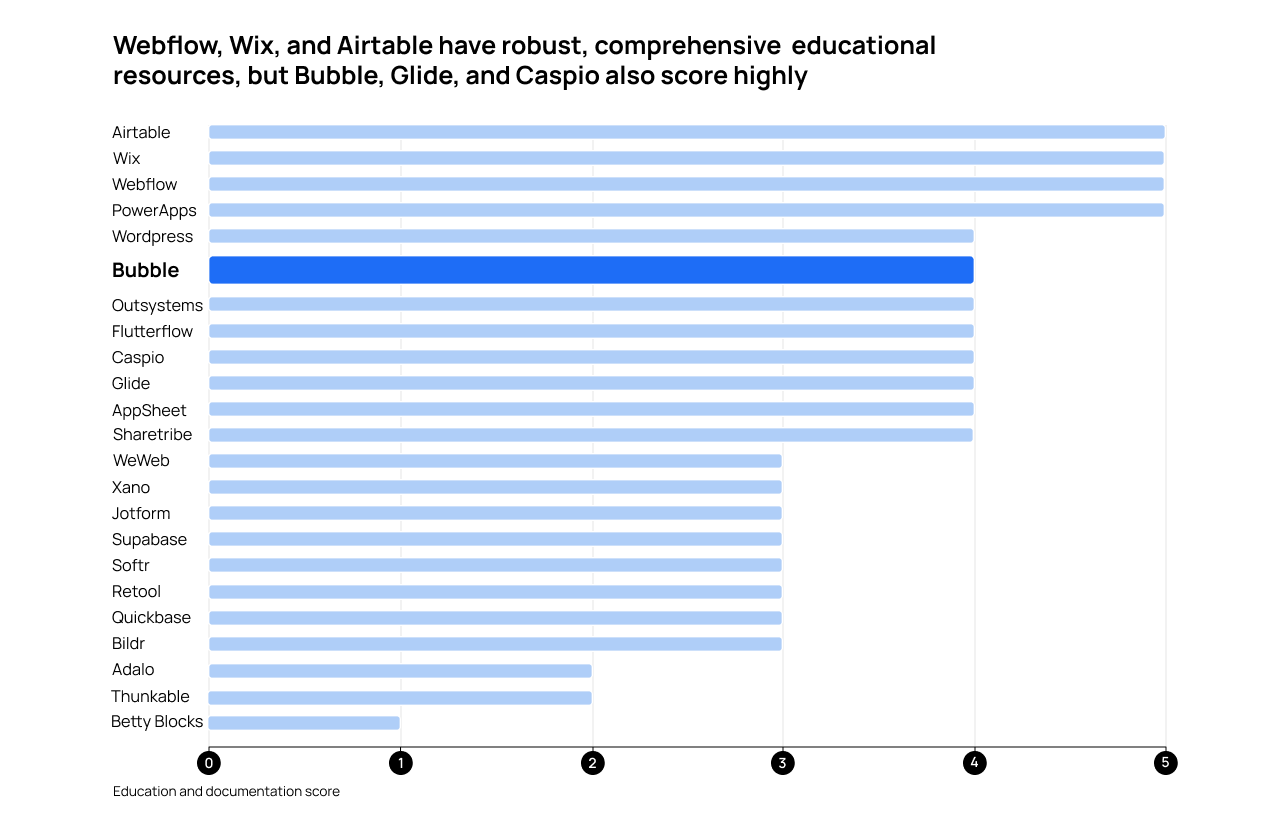
What these scores mean: We scored these tools’ resources on quality and comprehensiveness. Tools with high-quality resources got a score of 3, and we awarded extra points based on how much of the app creation process their libraries cover.
| Score | Criteria |
|---|---|
| 1 | Low-quality educational resources |
| 2 | Medium-quality resources |
| 3 | High-quality resources, low coverage |
| 4 | High-quality resources, medium coverage |
| 5 | High-quality resources, comprehensive coverage |
11. Community: How much help can you get from other humans?
When you’re stuck with a problem or question that Google and ChatGPT can’t answer, you can often find an online community of people willing to freely share their insights and expertise.
That’s why developers cited development community as a key factor to consider when making a no-code purchase decision. A large, active, and supportive community is an excellent source of help, whether you’re learning the ropes of a new tool or trying to solve advanced issues.
When gauging the quality of a no-code platform’s community, look for the following green flags.
Vendor-hosted discussion
If the company making the platform hosts their own online discussion space, it’s a good sign that they’re seeking to foster, communicate with, and listen to their developer and customer community. This may look like:
- Forums hosted on the company’s website
- A dedicated subreddit
- A Discord server or Slack workspace for developers using the platform
- A 24/7 support team
A company may provide some or all of these. But in general, it’s better to have one or two well-maintained community channels than a host of neglected ones.
Active community participation
An active community channel boasts a near-constant stream of new posts, replies, and reactions from many members. It’s a place where you can count on questions getting prompt and helpful responses. If a solution’s community is active, it will likely be your first line of defense when you need help.
When examining a community’s activity, keep an eye out for participation by employees of the no-code platform itself. Ideally, those employees will be actively providing input, endorsing helpful comments, and (if they’re admins) moderating discussion for civility and relevance.
In-person events
While online community is more important for the day-to-day, it’s also a good sign when the no-code solution’s company hosts community events. These may range from small local meetups to massive annual conferences. In-person events signal that the user community is engaged enough to physically meet with each other, share ideas, master product features, and celebrate wins.
No-code platforms, ranked on community
Of the 23 vendors we reviewed, 13 host robust community channels with active vendor participation. Furthermore, the top seven companies in this category regularly host community events. The average score in this area across all vendors is 3.7/5.
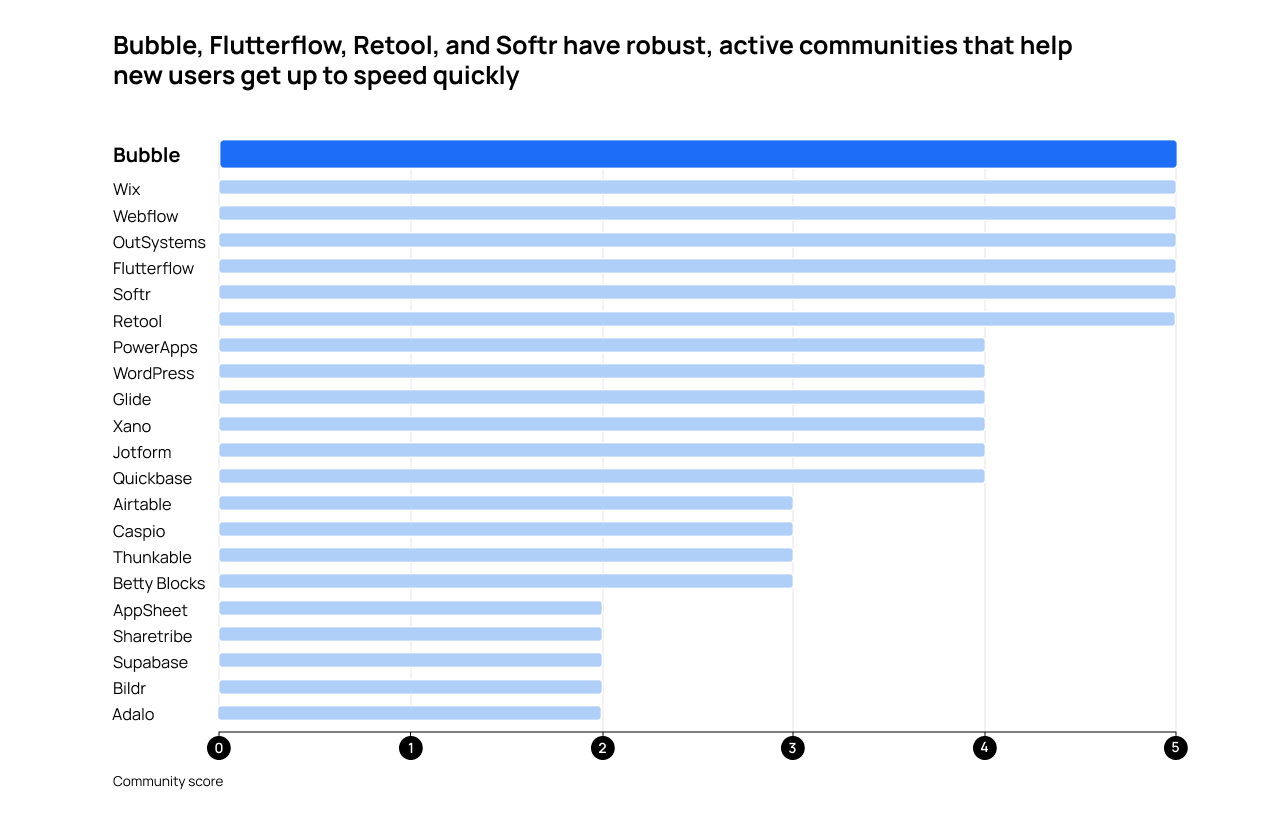
What these scores mean: We scored tools on community based on the qualities mentioned above: company-hosted community channels, community activity, company participation, and the presence of company-hosted events for the community. Companies that demonstrated all four got a perfect score.
| Score | Criteria |
|---|---|
| 1 | No community channels |
| 2 | Community channels exist, but participation is low |
| 3 | Active community, some company participation |
| 4 | Robust community, regular and valuable company participation |
| 5 | Everything in 4, plus in-person company events |
Choose the no-code app builder that’s right for you
Now you’ve got an idea of what factors to consider when choosing a no-code development platform, but this is just the beginning. Use this guide as a starter for creating your own evaluation system — one that grades no-code platforms on the only factor that truly matters: how well they fit your needs.
If you’ve come this far and want a full-stack platform that lets you build fully customizable apps across the broadest set of use cases, consider building your next project on Bubble. You can start building on Bubble for free (so you don’t pay while you’re still learning the tool), and Bubble’s workload-based pricing model scales as you grow. Our platform is part of a thriving ecosystem of integrations, plugins, and agencies, and we’ve fostered a huge, active, supportive developer community.
If that sounds like what you’re looking for in a no-code solution, give Bubble a try!
Build for as long as you want on the Free plan. Only upgrade when you're ready to launch.
Join Bubble
